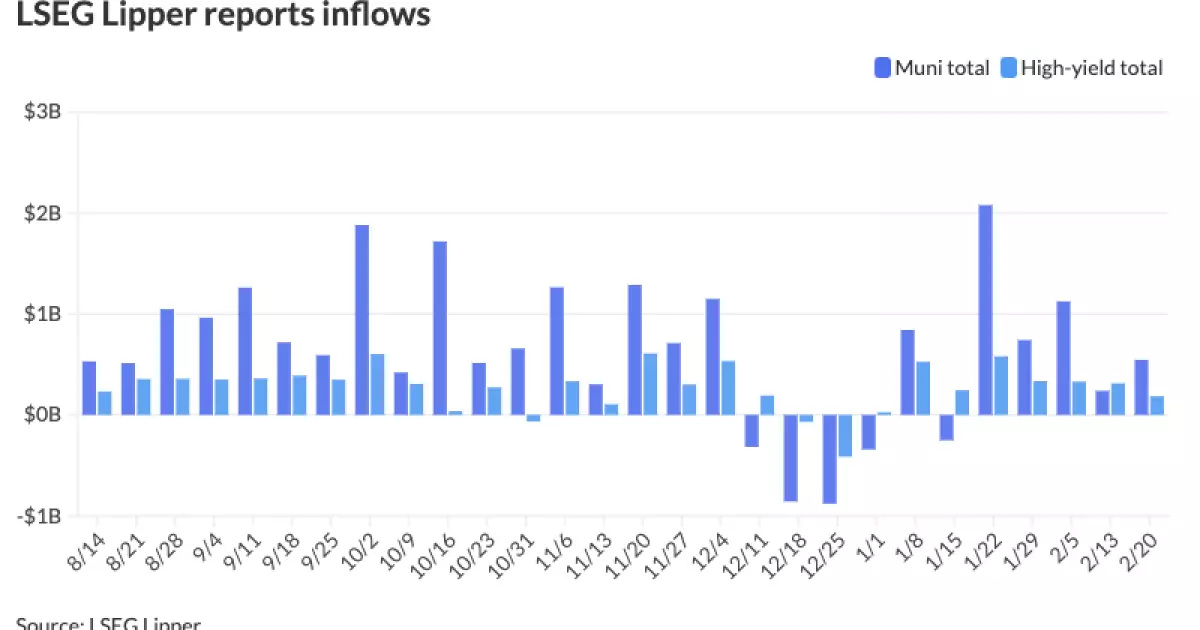In recent trading sessions, the municipal bond market has exhibited a stable yet slightly bullish trend, particularly highlighted by the pricing of a significant $2.5 billion deal related to the Brightline West Passenger Rail Project. With the backdrop of a quieter issuance environment and a subtle decrease in U.S. Treasury yields, the conditions appear ripe for investment in tax-exempt bonds, especially given that the equities market has demonstrated weakness. Data reflects that the two-year municipal ratio to UST (U.S. Treasury) was at 62%, with longer durations like the 30-year sitting at 85%. These ratios indicate a tightening but somewhat attractive valuation for municipal bonds compared to their Treasury counterparts.
Inflation has been a critical variable in market dynamics, with recent tariff-related impulses causing fluctuations in U.S. Treasury yields. In January, the 10-year UST yield peaked at 4.80% amid burgeoning concerns over tariff-induced inflation. However, markets adeptly recalibrated, leading to a stable close at 4.54% for that month. James Pruskowski, chief investment officer at 16Rock Asset Management, aptly summarizes this phase, stating that various macroeconomic narratives are now at play, all of which influence the volatility and range of interest rates.
As we transition into February, it’s observed that although rates exhibit erratic movements, they are largely contained within a defined range. Fund inflows continue to grow, suggesting investor confidence and a favorable outlook towards a potential future reduction in interest rates.
Looking ahead, the municipal market appears poised for a productive period due to several favorable factors. As highlighted by J.P. Morgan strategists, factors such as last week’s underperformance, considerable mid-month reinvestment capital estimated at $18 billion, and light supply levels will contribute to an advantageous setting for tax-exempt bonds. Despite low supply figures of about $4.3 billion—considerably diminished owing to the holiday-circumcised week—the healthy demand signals a robust environment for bond issuance.
Analysts caution, however, that challenges could emerge as the seasons shift. The anticipated rise in supply coupled with diminishing reinvestment capital in the months of March through May might lead to sporadic periods where investments can occur at more favorable pricing. Thus, it is crucial for investors to approach this landscape with adaptability and insight.
The primary issuance market remains vibrant, although the changing composition within the supply can create hurdles for targeting specific investment exposures. Pruskowski indicates the necessity for a proactive approach in navigating these evolving conditions, where well-managed dealer balance sheets might offer some buffer against upcoming seasonal weaknesses.
A pertinent trend to observe is the relative yield attractiveness of long-dated high-grade municipal bonds compared to their Treasury counterparts. With current yields resting near one-year highs for municipal bonds and three-year highs in relation to long-term UST, the prospect for financing via municipal bonds becomes increasingly appealing, especially for seasoned investors eyeing long-term gains as lower rates come into play by 2025.
Recent fund flow data provide additional context to the prevailing trends; municipal bond mutual funds reported an inflow of $546.3 million in the week leading up to Wednesday, a positive sign reflecting investor confidence. This surge follows a prior week that saw inflows of $238.5 million, reiterating a consistent pattern of growing interest.
In contrast, high-yield funds experienced a tailwind of $184 million, albeit lower than the previous week’s $313 million inflow. This indicates a more selective investment climate, where even within opportunistic segments, concentration is showing moderated enthusiasm. Tax-exempt money market funds reported outflows totaling $769 million, a counterintuitive shift amidst the broader upward trend in municipal investment.
As the landscape continues to evolve, investors must remain vigilant, capitalizing on market patterns while being considerate of the impending technical shifts anticipated for the upcoming months. The consistent and strategic positioning in the municipal market, leveraging the favorable dynamics this February offers, will likely yield significant traction in an otherwise tumultuous economic environment. The balancing act between inflows, interest rates, and investor appetite will shape the dictates of municipal bond performance, necessitating informed decision-making as the market navigates through complex conditions ahead.

